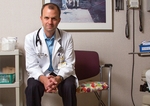Health
Quest for new antibiotics leads to novel sources
■ Clay and alligators are among things researchers are exploring to stop resistant infections. Physician groups continue to stress the importance of appropriate prescribing.
By Susan J. Landers — Posted May 5, 2008
- WITH THIS STORY:
- » Related content
Washington -- As bacteria become resistant to increasing numbers of antibiotics the search is on for new and effective antimicrobials. Researchers are hunting near and far -- on the ground and even in the swamps.
For instance, the minerals from certain clays, which have been used medicinally for thousands of years, could form the basis of a new generation of inexpensive antibiotics, researchers from Arizona State University reported at the national meeting of the American Chemical Society in New Orleans, April 6-10.
And proteins found in alligator blood are being eyed as powerful new medications that could help fight infections associated with diabetic ulcers, severe burns and the "superbugs" that are raising fears in the medical community. The alligator study was also presented at the chemical society's meeting.
The list of diseases that are becoming more difficult to fight with first-line antibiotics is growing longer. Included are tuberculosis, staph and strep infections, malaria, head lice and, recently, meningococcal disease. Methicillin-resistant Staphylococcus aureus, or MRSA, is particularly notorious for making the jump from a hospital problem to one that causes illness and deaths in communities.
This dangerous trend has prompted efforts by public health and medical societies, including the AMA, to educate physicians about the importance of appropriately prescribing antibiotics and the need to inform patients about the dangers of antimicrobial resistance.
Thinking outside the box
The importance of the quest for new medications has sparked interest in the healing powers of clay. "The catch word is MRSA," said Shelley Haydel, PhD, assistant professor in the School of Life Sciences and the Biodesign Institute at Arizona State University in Tempe. "We've shown in the laboratory that [some clay] does have some effectiveness at killing MRSA."
Clay's power was a surprise to Dr. Haydel. "When I first got involved, I looked at it with a skeptical eye," she said. But when a paste of clay killed bacteria in 12 hours, she was hooked. Dr. Haydel and her colleagues have screened about 30 different clays -- samples from all over the world -- and found three with antimicrobial properties.
Dr. Haydel isn't sure what the medical community's response will be to this unorthodox approach. "We have to show that it is safe -- and we believe that it is safe because it's been used for so long -- and effective at getting rid of infections in test subjects.
"If we don't have to know exactly how it is working and just show that it is working and not causing additional harm, we may be a couple of years away from clinical use."
Meanwhile, Mark Merchant, PhD, assistant professor of biochemistry at McNeese State University in Lake Charles, La., is wrestling alligators in the pursuit for a new antibiotic. After subduing a gator he extracts blood.
Previous studies by Dr. Merchant showed that alligators have unusually strong immune systems that can fight fungi, viruses and bacteria without having prior exposure to them. Scientists believe this is an evolutionary adaptation to promote quick wound healing, as alligators are often injured during territorial battles in the unhygienic world they inhabit.
Dr. Merchant and colleagues have already isolated white blood cells and extracted the active proteins.
"We're very excited about the potential of these alligator blood proteins as both antibacterial and antifungal agents," he said. "There is a real possibility that you could be treated with an alligator blood product one day." However, that day is not likely to arrive for seven to 10 years.
In another development, the Food and Drug Administration approved a test April 3 that allows rapid screening for MRSA. The nasal test, which will provide results within 24 hours according to the manufacturer, improves on the two-day wait that had been necessary previously.












